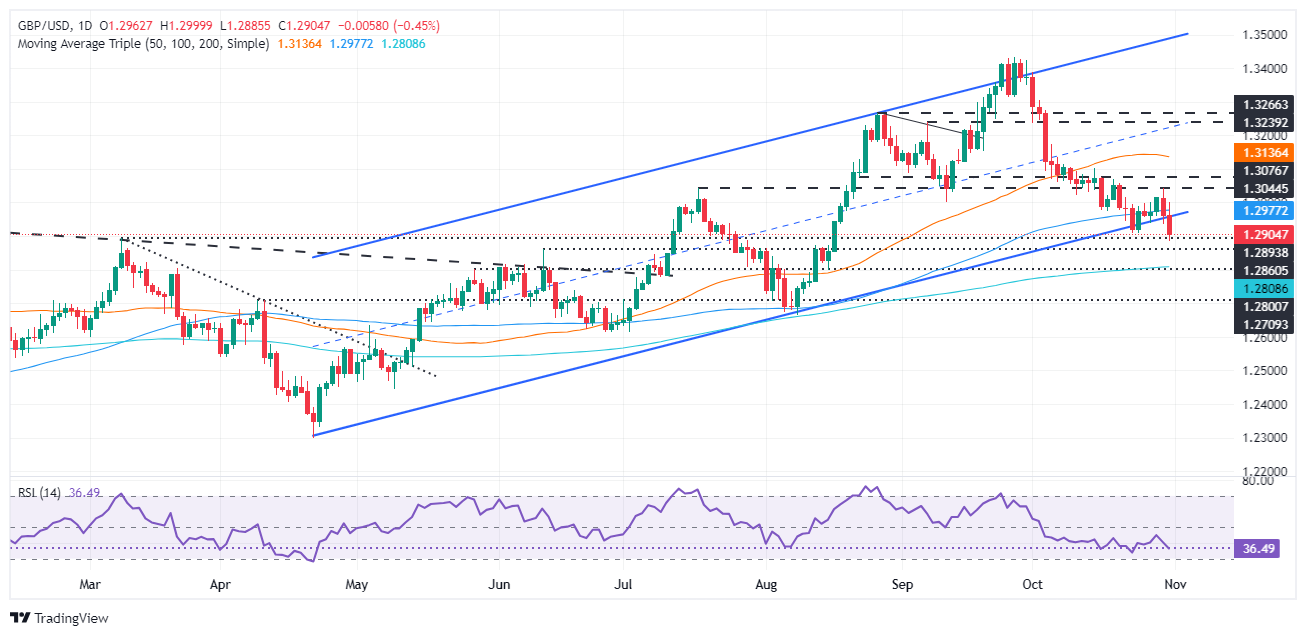GBP/USD Price Forecast: Tumbles to two-month low, traders ditch GBP on UK's budget
- GBP/USD breaks below the 100-day SMA at 1.2975, with further downside possible if it closes below the 1.2900 mark.
- Key support lies at 1.2885, with the 200-day SMA at 1.2807 as the next target for sellers.
- Resistance emerges at 1.2950/60, with RSI signaling bearish momentum approaching oversold conditions, potentially capping a rebound.
The Pound Sterling dropped to a new two-month low of 1.2885 against the Greenback during the session, as UK Gilts rose sharply following the budget release. However, the GBP/USD has recovered some ground yet is losing over 0.30% and trades at 1.2918.
GBP/USD Price Forecast: Technical outlook
The GBP/USD has broken below the 100-day Simple Moving Average (SMA) at 1.2975, extending its losses below the ascending channel support trendline, paving the way for further downside.
Although the 1.2900 figure was cleared, Pound sellers must achieve a daily close below it. In that outcome, the GBP/USD's next support would be 1.2885, the day’s low, followed by the 200-day SMA at 1.2807.
Conversely, if buyers keep the GBP/USD afloat above 1.2900, the first resistance would be a previous support trendline at around 1.2950/60 before bulls can test 1.2999.
Oscillators favor further GBP/USD downside, as the Relative Strength Index (RSI) deepened its fall in bearish territory, about to reach oversold conditions.
GBP/USD Price Chart – Daily
Pound Sterling FAQs
The Pound Sterling (GBP) is the oldest currency in the world (886 AD) and the official currency of the United Kingdom. It is the fourth most traded unit for foreign exchange (FX) in the world, accounting for 12% of all transactions, averaging $630 billion a day, according to 2022 data. Its key trading pairs are GBP/USD, also known as ‘Cable’, which accounts for 11% of FX, GBP/JPY, or the ‘Dragon’ as it is known by traders (3%), and EUR/GBP (2%). The Pound Sterling is issued by the Bank of England (BoE).
The single most important factor influencing the value of the Pound Sterling is monetary policy decided by the Bank of England. The BoE bases its decisions on whether it has achieved its primary goal of “price stability” – a steady inflation rate of around 2%. Its primary tool for achieving this is the adjustment of interest rates. When inflation is too high, the BoE will try to rein it in by raising interest rates, making it more expensive for people and businesses to access credit. This is generally positive for GBP, as higher interest rates make the UK a more attractive place for global investors to park their money. When inflation falls too low it is a sign economic growth is slowing. In this scenario, the BoE will consider lowering interest rates to cheapen credit so businesses will borrow more to invest in growth-generating projects.
Data releases gauge the health of the economy and can impact the value of the Pound Sterling. Indicators such as GDP, Manufacturing and Services PMIs, and employment can all influence the direction of the GBP. A strong economy is good for Sterling. Not only does it attract more foreign investment but it may encourage the BoE to put up interest rates, which will directly strengthen GBP. Otherwise, if economic data is weak, the Pound Sterling is likely to fall.
Another significant data release for the Pound Sterling is the Trade Balance. This indicator measures the difference between what a country earns from its exports and what it spends on imports over a given period. If a country produces highly sought-after exports, its currency will benefit purely from the extra demand created from foreign buyers seeking to purchase these goods. Therefore, a positive net Trade Balance strengthens a currency and vice versa for a negative balance.

